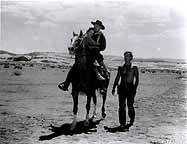 The
Western
The
Western  The
Western
The
Western
From the earliest days of filmed entertainment, the western's appeal has cut across lines of taste and expectation. Usually characterized by alternating sequences of action and contemplation, or tension and repose, it is the one genre in which "setting" functions as a living character. Danger is emotionally crucial to the western formula. Its characters, often spirited pioneers, tend to resort to primitive, wordless communication. Horses and cattle generally serve as living emblems of a natural society in which risks must be taken daily. Two consistent story elements in the formula are the chase, or extended pursuit, and the dramatic confrontation, or shoot-out.
During the decades before sound, westerns were simple and action-packed. The real American West was still fairly wild in 1903, when a mustachioed gunman in Edwin S. Porter's The Great Train Robbery pointed his six-shooter at the audience and "shot" them. Heroes such as "Bronco Billy" Anderson were pitted against clearly defined evil—killers dressed in black or treacherous cowhands wearing measured sneers. In reel after reel, these early villains were dispatched by such masters of the quick draw and uncanny aim as Anderson and his immediate successors, William S. Hart and Tom Mix.
There were several early attempts to expand the horizons of the genre. In 1923, director James Cruze delivered the first "epic" western, The Covered Wagon, which traced a long, arduous journey to California. The following year The Iron Horse, dramatizing the building of the first transcontinental railroad, was released to an enthusiastic reception. It was directed by a 29-year-old Irish-American whose name would eventually become synonymous with the genre, John Ford. The success of these films stepped up their rate of production, with the studios cranking out a hundred or more westerns a year. Quantity did not entail quality, however; well into the sound era, producers continued to view the genre in simple "shoot-em-up" terms. Two exceptions among early sound films were Raoul Walsh's The Big Trail (1930), notable for its early use of wide-screen photography and the presence of a young actor named John Wayne, and Wesley Ruggles's Cimmaron (1931), which became the first (and until Dances with Wolves in 1990 and the only) western to win the Oscar for Best Picture.
The aesthetic significance of location and the perfect deployment of chase and confrontation are nowhere more evident than in the sound-era westerns of John Ford. The dramatic climaxes of his best works, including Stagecoach (1939) and The Searchers (1956), unfold against a panoramic landscape often ridged with mountains or interrupted by the distinctive rock formations found in his favorite setting, Monument Valley. A new sophistication The work of Ford opened the genre up for more serious examination, and a number of first-rate directors staked their own claims in the cinematic West. Among them were Howard Hawks (Red River, 1948; Rio Bravo, 1959); Anthony Mann (Winchester '73, 1950; The Naked Spur, 1953); Budd Boetticher (Ride Lonesome, 1959); and Sam Peckinpah (Ride the High Country, 1962.The so-called B westerns continued to flourish until the 1950s, when their audience was stolen by television. The 1940s also saw the rise of the singing cowboy, typified by Gene Autry and Roy Rogers, and of several smaller studios, among them Republic and Monogram, which specialized in the low-budget end of the genre.
Although the western has often been characterized as predictable, escapist fare, the genre has proved capable of reflecting changes in contemporary attitudes. The vicious treatment received by Native Americans during the settlement of the West was acknowledged in a number of films, from Delmer Daves's Broken Arrow (1950) to Arthur Penn's Little Big Man (1970). The graphic violence of Peckinpah's The Wild Bunch (1969) reflected the climate on U.S. city streets as well as the events taking place in the jungles of Southeast Asia. By the late 1960s the genre seemed to have played out its hand. Overexposed in a multitude of television series, ridiculed as inaccurate and irrelevant, there seemed no avenue for it to pursue except self-parody. The so-called spaghetti westerns, produced mainly in Spain by Italian filmmakers, seemed to fulfill that dubious promise, although the best examples of the subgenre came closer to tribute than mockery. The films of Sergio Leone in particular (A Fistful of Dollars, 1964; For a Few Dollars More, 1966; and The Good, the Bad, and the Ugly, 1966) displayed a compelling visual style and propelled Clint Eastwood to international stardom.
Decline The 1980s saw the number of western features dwindle, in some years, to none. The colossal box-office disaster of Michael Cimino's Heaven's Gate (1980) made critics sound the death knell for the genre, but the it proved more resiliant than imagined. Laurence Kasdan's Silverado (1985) and Clint Eastwood's acclaimed Unforgiven (1991) proved that rumors of the genre's death were greatly exaggerated. Also worth mentioning were a pair of self-consciously offbeat character studies, by the Australian director Fred Schepisi (Barbarosa, 1982) and Canadian Phillip Borsos's The Grey Fox (1982).